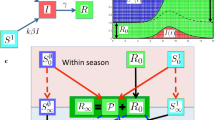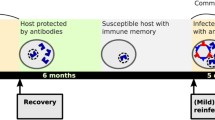Abstract.
The persistence of Influenza A in the human population relies on continual changes in the viral surface antigens allowing the virus to reinfect the same hosts every few years. The epidemiology of such a drifting virus is modeled by a discrete season-to-season map. During the epidemic season only one strain is present and its transmission dynamics follows a standard epidemic model. After the season, cross-immunity to next year's virus is determined from the proportion of hosts that were infected during the season. A partial analysis of this map shows the existence of oscillations where epidemics occur at regular or irregular intervals.
Similar content being viewed by others
Author information
Authors and Affiliations
Additional information
Received: 16 February 2001 / Revised version: 11 June 2002 / Published online: 28 February 2003
Key words or phrases: Infectious disease – Influenza drift – Cross-immunity – Seasonal epidemics – Iterated map
Rights and permissions
About this article
Cite this article
Andreasen, V. Dynamics of annual influenza A epidemics with immuno-selection. J. Math. Biol. 46, 504–536 (2003). https://doi.org/10.1007/s00285-002-0186-2
Issue Date:
DOI: https://doi.org/10.1007/s00285-002-0186-2




